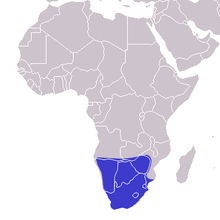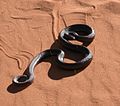Mole snake
| Mole snake | |
|---|---|

| |
| Scientific classification | |
| Domain: | Eukaryota |
| Kingdom: | Animalia |
| Phylum: | Chordata |
| Class: | Reptilia |
| Order: | Squamata |
| Suborder: | Serpentes |
| Family: | Pseudaspididae |
| Genus: | Pseudaspis Fitzinger, 1843 |
| Species: | P. cana
|
| Binomial name | |
| Pseudaspis cana | |

| |
Distribution of the mole snake
| |
| Synonyms[2] | |
| |
The mole snake (Pseudaspis cana) is a species of snake. It has been placed in the family Lamprophiidae, and more recently in the family Pseudaspididae, along with the genus Pythonodipsas. It is native to much of southern Africa, and is the only member of the genus Pseudaspis. A study showed that P. cana is caught and consumed by the honey badger, among other species. Remains of the mole snake were found in the faeces, and suggest the consumed individuals were larger specimens.[3]
Taxonomy
P. cana was originally described by Carl Linnaeus in his landmark 1758 10th edition of Systema Naturae. Its original binomial name was Coluber cana. Since then, it has also been called Coronella cana by André Marie Constant Duméril, Gabriel Bibron and Auguste Duméril in 1854, before being reclassified as Pseudaspis cana by Edward Drinker Cope in 1864.[2] P. cana is the only species in genus Pseudaspis. The genus has been placed in the family Lamprophiidae. More recently it has been placed in the family Pseudaspididae, along with the genera Buhoma and Pythonodipsas, although a 2019 study concluded that the status of Pseudaspididae "deserves to be viewed with caution", and Buhoma may not belong in the family.[4]
Description
The mole snake can grow to a total length (including tail) of 2 m (6 ft 7 in).[5] A small head and pointed snout are characteristics of the species.[6] It has a firm, tubular body. Like the majority of the Lamprophiidae, P. cana is not venomous.
In mature individuals, the body is mostly one colour, and may vary from yellow to brown to grey, and in some cases, solid black.[5] The young have dark markings and spots that are gradually lost as the individual ages.[6] Colour may be related to geography; in the south, most specimens are black, whereas specimens found in the northern part of their range are brown, reddish-brown, grey, or yellow.
Diet
The primary food source of P. cana is golden moles (hence the common name), rodents, and other small mammals.[6][7] For this reason, it is considered useful for the natural control of problem rodents.
Its diet may also include the eggs of seafowl. At
The mole snake is a nest predator of the Karoo prinia (Prinia maculosa). P. cana is one of at least six snake species which cause reproductive loss and decrease of nest success in P. maculosa.[9]
Distribution and habitat
The range of the mole snake encompasses most of southern Africa.
The mole snake lives in the abandoned burrows of other animals. It can be found in a variety of habitats, such as the
Reproduction
The mole snake is viviparous, mating takes place in late spring (October),[10] and the female gives birth to usually between 25 and 50 young, with as many as 95 possible. The young snakes are 20 to 30 cm in length at birth.[11]
In captivity
The mole snake can be "quite ferocious".[7] Though not venomous, they can cause severe bite wounds. Despite this, they are said to make good pets when sufficiently settled.[7]
Gallery
-
Juvenile mole snake (Pseudaspis cana) during sunbathing
-
A mole snake near Rehoboth, Namibia
-
Juvenile mole snake, Auob River bed, Kgalagadi Transfrontier Park, South Africa
-
A mole snake, Nossob River, Kgalagadi Transfrontier Park
-
A mole snake, Lijersdraal picnic site, Kgalagadi Transfrontier Park
References
- ^ Beraduccii, J., Howell, K., Msuya, C.A. & Ngalason, W. 2021. Pseudaspis cana. The IUCN Red List of Threatened Species 2021: e.T44979717A44979726. Downloaded on 05 September 2021.
- ^ a b Species Pseudaspis cana at The Reptile Database www.reptile-database.org.
- . Retrieved 25 January 2010.
- PMID 31075128.
- ^ a b c Skubowius, Bernd (6 January 2008). "Keeping of the African Mole Snake". Pinesnake.de. Retrieved 23 January 2010.
- ^ a b c d Fitzsimons, V.; Brain, C.K. "A Short Account of the Reptiles of the Kalahari Gemsbok National Park". pp. 102–103. Retrieved 25 January 2010.
- ^ PMID 19653521.
- . Retrieved 25 January 2010.
- ^ Nalwanga, Dianah; Penn Lloyd; Morné A du Plessis; Thomas E Martin (2004). "The influence of nest-site characteristics on the nesting success of the Karoo Prinia (Prinia maculosa)" (PDF). Ostrich. South Africa: NISC Pty Ltd. Retrieved 25 January 2010.
- ISBN 1868720403.
- ISBN 1868722813.
 Media related to Pseudaspis cana at Wikimedia Commons
Media related to Pseudaspis cana at Wikimedia Commons






